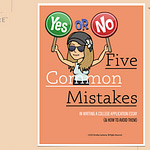So I guess my point is, let’s step back.
If I could put a couple people or a couple organizations out of business, I would put the U. S. News and Report out of business; I’d put the Washington Monthly out of business, or I would at least extract from every social media organization that lists of the best and worst high schools, colleges, hospitals — garbage disposals, because we live by this, we live by this benchmark that if we’re not doing what our neighbors or our friends or our relatives, someone’s doing, we’re not doing well.
Christine: Right.
Something that I found really interesting in examining school profiles is that parents can kill themselves with this quest of getting into a neighborhood or a home that puts them in the school district that’s on the top of one of those lists. And then the student doesn’t fully take advantage of everything that high school offers and that ends up working against the student in the whole college application process.
It doesn’t bode well for the student who didn’t take advantage of everything that school offered. So maybe it’s not the best idea to let somebody else decide what the number one school district is in your area. Maybe it depends more on your kid. What is your kid interested in? Where does your kid want to spend his or her time?
Tom: That's, that's very true. It’s very true. But one will also say that the colleges take all those high school profiles and put them into their database and they use their algorithms to find out what students are in the best schools.
So we want to take students from those best schools. Who’s to say that there isn’t equality in that type of school system, and they are equal on the playing field?
So there’s the problem with that, you know, and again, it's another process that’s driven by data, and data is wonderful. And we’re getting more and more data and we’re using more and more data, but we have to get rid of some of that data. We have to, we have to supplement that data with human beings.
Christine: With the personal element.
Tom: With the personnel element. So I think that you’ll be seeing, possibly, in the next couple of years, more and more movement from the colleges back to the days of interviews, from the ’70s and ’80s.
I’m hopeful colleges are going to use their admissions representatives in a different way to convert them from being data collectors because there are enough organizations that are selling information to schools to colleges about high school students and all of that stuff. Okay. So if we’re buying 100,000+ names from a provider of lists, then let’s find who we want in our recruitment profile: achievers, medium strugglers that we can turn around and make better students out of by taking a risk on them. And let's send our admissions people out to find them.
I mean, I did a program years ago up at a college in Vermont because the, the director of admissions and I used to work together, and he was there. I went in, and my goal was to have a conversation about the fact that you are salespeople, you are client relations professionals, recruiting individuals who are going to come to this school. They’re going to do well. They’re going to graduate and they're going to become strong contributing alumni.
And I started the program by saying, you don’t work for him anymore, you work for me. And you need to represent at the admissions table. Each of you needs to bring in 60 students who are going to fill that profile. Of those 60 students, you’ll get a 10 percent raise if they stay for four years, use all the services, and graduate.
But if you can’t, Maybe you're not in the admissions business that we should be in, but that’s not the admissions business we run.
So that’s where I spend a lot of time as an advisor. Once the student starts narrowing their list to a manageable one, (and I shouldn’t say this too loudly because the admissions people will know they’re coming, but) I want those students to proactively go out and meet and greet and share their resume and AP classes from the rural cities and towns in Virginia or Massachusetts, who can demonstrate that they can carry a conversation, they can sell themselves, they are articulate, and they’re doing some innovative things.
I want to meet that kid. I want that kid on my campus.
Christine: Yes, exactly.
Going back to what you said about if you could take anything away, I think if I were a university, I wouldn't give students the summer to write their college application essays. I wouldn’t even look at them. I would give them a proctored interview or exam, kind of like what they do with the SAT, and I would present them with the prompts there and see what they write during that time slot.
Tom: That’s what an interview back in the day was. I mean, when my oldest, definitely when Megan was going through the process, she went and did interviews. She wrote her essay, but she also went to present herself and answer questions. You can’t do that with 100,000+ applicants.
Christine: No. No, but a lot of these schools, the reason they’re getting 100,000+ applicants is because they’re working so hard to keep their acceptance rate at 4 percent.
Tom: They’re coming up with new programs to send you to different locations. You can get accepted at a Boston school, but you’re going to take your first semester or your first year overseas or in California or now in New York because they just purchased a school in New York. You are accepted into our family of institutions.
Everybody’s all giddy.
But they’re now finding that students are having problems with that. Number one, we really didn't know that we were going to pay for it all out of our own pocket. There was no scholarship. There was no financial aid. And when we come back after the first semester, if we come back after the first semester, we’re not accepted as if we had been there at the very beginning.
So the transition process is becoming more and more difficult for some of these students. And it’s catching on.
Christine: And students are hearing about it from other students.
Tom: Yes, and other schools across the country are doing it.
I don’t have a problem if you’re going to be accepted at my institution and you’re going to take classes next door in a school that we absorbed, but it’s five minutes from us, and we need that space, and we need that opportunity to do our thing, and we’re going to do it well.
But why do we send them to Europe? And as soon as we get that acceptance letter, the parents are booking their vacation trip to go with them.












